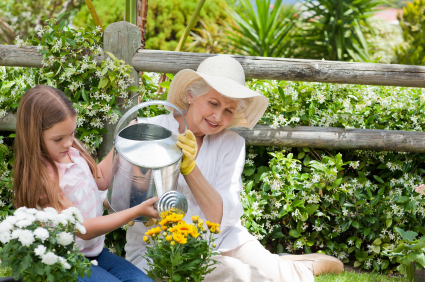The Summer of Wellbeing, Part VI

(Note: this article is part of a series. You may want to read the previous installments, Moving Your Body, Feeding Your Body, Reducing Stress, Cultivating Positive Emotions, and Building Strong Relationships first.)
Thirty years ago, a professor of Architecture named Roger Ulrich organized a now-classic study with a group of patients recovering from gallbladder surgery. Half of the patients were placed in hospital rooms whose windows exposed a group of deciduous trees; the other half had windows that opened to a brown brick wall. Which group do you think had an easier recovery?
As you might have guessed, patients who had the view of trees tolerated pain better, appeared to nurses to have fewer negative effects, and were even released from the hospital earlier. The results of this study were clear: our environment has an impact on our bodies and minds.
"Environment" can refer to the physical space around us. This includes both the natural world (water, air, earth, vegetation, and animals) and the build environment (man-made furnishings, buildings, roads, and other infrastructure). What you are seeing, hearing, and experiencing at any moment is changing not only your mood, but how your nervous, endocrine, and immune systems are working. What Ulrich's study pointed out was that we need to consider our interactions with the world around us to optimize our wellbeing, and one key way to interact in a positive way with our world is to re-connect with nature.
Nature heals
Have you ever taken a walk around the park to "chill out" after a particularly stressful day? Perhaps you noticed that looking up at the trees or stopping to smell a fragrant flower made you feel calmer. Research is beginning to validate what seems like common sense: being in nature or even viewing scenes of nature reduces anger, fear, and stress and increases pleasant feelings. Exposure to nature not only makes you feel better emotionally, it contributes to your physical wellbeing, reducing blood pressure, heart rate, muscle tension, and the production of stress hormones. Even a simple plant in a room can have a significant impact on stress and anxiety, so if you need to re-center after a rough day but don't have the time or ability to get outside, simply spending some quiet time watering your potted fern or gazing into a picture of a quiet forest can have a positive impact on the way you feel.
It's not just a stress-buster, either--nature is associated with fewer physical health complaints and may even make you live longer.
Nature restores
Furthermore, time in nature or viewing nature scenes  increases our ability to take on new mental tasks and pay attention. One explanation for this is that nature provides a respite from the constant effort to screen out competing stimuli in our busy lives. Because humans find nature inherently engrossing, we don't have to make an effort to focus when presented with natural views. This reduces mental fatigue and refreshes the mind. Some research in children with ADHD even shows that time spent in nature increases their attention.
increases our ability to take on new mental tasks and pay attention. One explanation for this is that nature provides a respite from the constant effort to screen out competing stimuli in our busy lives. Because humans find nature inherently engrossing, we don't have to make an effort to focus when presented with natural views. This reduces mental fatigue and refreshes the mind. Some research in children with ADHD even shows that time spent in nature increases their attention.
Nature connects
Time in nature connects us to each other and the larger world. A series of field studies conducted by the Human-Environment Research Lab at the University of Illinois suggest that residents in Chicago public housing who had trees and green space around their building reported knowing more people and having stronger feelings of unity with neighbors than tenants in buildings without trees. In addition to this greater sense of community, they had a reduced risk of street crime, lower levels of violence and aggression between domestic partners, and a better capacity to cope with life's demands, especially the stresses of living in poverty.
This experience of connection may be explained by studies that used fMRI to measure brain activity. When the subjects in these studies viewed nature scenes, parts of the brain associated with heightened empathy, love, and positive mental outlook were activated. When they viewed urban scenes, they activated parts of the brain associated with fear and anxiety. It appears as though nature inspires feelings that connect us to our community and our environment.
Too much time in front of screens is deadly
Likewise, a lack of time in the natural world can make us feel more disconnected and unhappy. "Nature deprivation," largely due to hours spent in front of TV or computer screens, has been associated with depression, loss of empathy, and lack of altruism, and even a higher risk of death. This is of particular concern in our modern, busy lives--it's very easy to spend an entire day looking at our computers, our cell phones, and our televisions, without paying any attention to the greenspace outdoors or the plants on our desk.
This is an example of how you can create an environment that is not working toward your wellbeing--a living room full of screens is bad for you, much like overeating or smoking!
What You Can Do
It's simple: get outside, somewhere green, preferably under your own power (or at very least, get some plants!)
- Spend time outdoors whenever you can. You get double benefit if you enjoy the outdoors actively--gardening, walking, or biking. If you can, walk or bike where there is vegetation or water--some elements of greenspace.
- Consider how much time you spend each time in front of a screen (TV or computer). Could you reduce that time to go outside or interact with friends or family?
- Add plants you find attractive to your home and office (and bring them to friends and family who are sick). Consider putting up scenes of nature that you like in your home and office. Make the interior spaces you live in feel beautiful and healing.
- And finally, realize that our relationship with nature is not a one-way street. Our connection with nature demonstrates that we need to protect it--for its sake and for our own.


